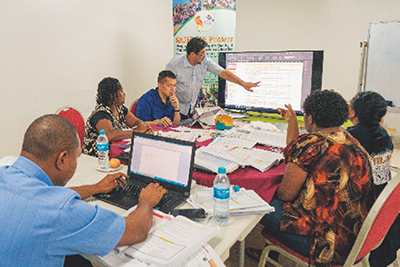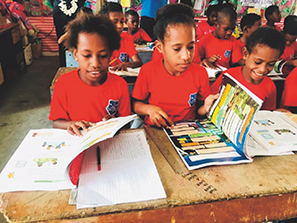Stories from the Field 6
Papua New Guinea’s First National Textbooks and Teacher’s Manuals Completed!
—Japan's know-how of developing textbooks is contributing to locally tailored learning for children—

Japanese experts and their Papua New Guinean counterparts developing textbooks and teacher’s manuals suited to the local situation (Photo: JICA)

Papua New Guinean children learning with the newly developed textbooks (Photo: JICA)
Papua New Guinea, with a large number of primary and secondary schools scattered far from the city, has faced a major challenge in the quality of teachers in remote areas that are difficult to access. For example, some teachers have to conduct classes without sufficient subject knowledge. An advanced Outcomes-Based Education was introduced in 2001 as part of a curriculum reform, but no nationally standardized textbooks or teacher’s manuals were developed, and the teachers, left largely to their own discretion, conducted classes relying on their own teaching skills using reference materials produced by various overseas publishers. As a result, the quality of education could not be ensured and teachers were unable to provide adequate instruction for the children, and it has drawn mounting criticisms that children’s academic abilities had declined.
Thus, the Papua New Guinean National Department of Education decided to discontinue the Outcomes-Based Education in 2014, replacing it with a newly introduced Standards-Based Curriculum and developing national textbooks. However, as the country had never developed national textbooks before, there was a lack of sufficient knowledge and experience.
Under these circumstances, the National Department of Education requested cooperation from Japan, which had been providing support in the field of science and mathematics education in the country since 2005. In 2016, the “Project for Improving the Quality of Mathematics and Science Education” was launched to develop national textbooks and teacher’s manuals for third to sixth grade primary school students and teachers across the country.
Teachers and curriculum development staff appointed by Papua New Guinea and Japanese experts gathered together and collaborated to develop the first national textbooks for approximately four years. Incorporating Japan’s lesson study methods (mock lessons) and know-how provided by the Japanese textbook publishing company GAKKOTOSHO Co., Ltd., they devised various ways to make the content easy to understand for the children and teachers in Papua New Guinea by including plenty of photographs and illustrations and introducing the country’s nature and culture. When setting math questions, as units of money and other familiar items differ from those in Japan, they consulted with the Papua New Guinean teachers on each and every aspect to adjust the content to reflect their local situation.
“The experience of being entrusted with developing national textbooks, which are at the foundation of nation-building and human resources development, was an extremely precious opportunity. From the second year, the teachers’ mock lessons to verify the contents of the textbooks were held in a training camp style, and between classes, verification, and preparations for the next class, they worked barely without rest,” said Mr. ITO Akinori, a JICA Expert involved in the textbook development looking back on that time.
“Most amazing of all, the passion of the Papua New Guinean teachers to improve the level of education in their country could be seen. It was a great honor for us to be able to witness the starting point of the future of education in Papua New Guinea,” said Mr. SERIZAWA Katsuaki and Mr. KOMAZAWA Susumu of GAKKOTOSHO Co., Ltd., who participated in the project. They continued as follows: “Japanese textbooks are excellent because the learning contents are exceptionally systematic. For example, after learning multiplication, students learn to calculate area. They are devised so that each unit teaches new items based on the content completed in previous ones. In this way, each unit is completed step by step. Students can properly acquire all of the necessary knowledge in just six years. We received jubilant comments from Papua New Guinean teachers about the Japanese textbooks, saying, ‘I really learned a lot,’ and ‘Now for the first time I understand what kind of learning content is needed.’”
The science and mathematics textbooks and teacher’s manuals, which took approximately four years to complete, have been in use since the new school term in February 2020. Unlike Japan, where the textbooks are distributed to each and every child for their own use, in Papua New Guinea, teachers collect them at the end of lesson. These new textbooks that made use of Japanese know-how are used over and over again in places of learning, and are contributing greatly to improving the quality of education in Papua New Guinea.
<< Previous Page Next Page >>
Main Text | Reference Statistics | Reference Materials | Stories from the Field | Master Techniques from Japan to the World | ODA Topics
